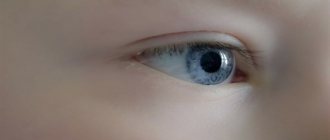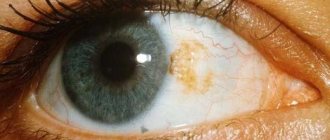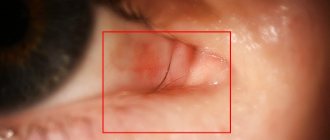Causes of souring
There are many conditions and diseases that cause secretion from the eyes:
- proliferation of opportunistic microflora with decreased immune function;
- bacteria entering the eye area that spread to the conjunctiva;
- allergic reactions to plants, animal hair, chemicals and household substances;
- viral eye infection;
- mechanical damage followed by penetration of a bacterial agent into the affected area;
- finding a foreign body under the eyelids;
- inflammatory conditions of the conjunctival sac, eyelids, cornea, mucous membrane;
- blockage of the tear duct, which can be congenital or acquired, is formed due to the accumulation of purulent exudate or saline contents.
The doctor must identify the root cause of the condition to prevent recurrence of the process. If the disease is treated symptomatically, the bacterial or viral infection may recur.
An adult's eyes turn sour
Contents [Show]
Comments:
Rating: 93
Table of contents:
The trouble when the eyes turn sour is in most cases associated with the development of conjunctivitis.
However, this symptom can also be observed with other eye diseases. Let's try to understand in more detail why the eyes turn sour, and what measures can be taken about this.
The following causes of sour eyes in an adult can be identified:
- Dacryocystitis. This is an inflammation of the lacrimal sac caused by bacteria. In addition to acidification, there is swelling in the corners of the eyes, a feeling of fullness in the affected area, tearing, discharge of pus when pressing on the lacrimal sac, and sometimes the pupils dilate.
- Conjunctivitis. It is an inflammation of the thinnest membrane that covers the eyelids on the inside and passes from them to the eyeball, practically spreading to the cornea. For the same reason, children's eyes may become sour. In this condition, the eyes become red and watery. There should not be any sensation of a foreign body. Viruses, bacteria, fungi, allergic reactions, and eyelash extensions can cause conjunctivitis. Of the viruses, two varieties are worth special mention: herpes simplex and adenovirus, which belongs to the ARVI group. Adenoviral conjunctivitis is considered contagious. When it appears in a team of at least one employee, there is a high probability of infecting other employees with it through contact with the patient’s belongings. In addition, the disease can be transmitted through airborne droplets. Herpetic conjunctivitis is a danger to vision. The virus quickly penetrates deep-lying structures, leading to irreversible consequences for visual function.
- Other reasons. The eyes of an adult also become sour in conditions explained by infection entering the conjunctival sac due to other eye ailments, accompanied by lacrimation or dryness of the visual organs. This may be associated with blepharitis, glaucoma, dry eye syndrome, and trauma to the visual organ.
Return to contents
When your eyes turn sour, you must visit an ophthalmologist and undergo the necessary examination. Incorrect treatment or neglected condition can cause loss or deterioration of visual function.
If you cannot get to a doctor immediately after the first symptoms of sour eyes appear, the condition can be improved by applying some measures at home. You can try rinsing your eyes with special saline solutions purchased at the pharmacy. Instillation of antiseptic drops that act on a large number of microbes also helps. If sour eyes are accompanied by sneezing and a runny nose with clear nasal discharge, there is a high probability of allergic conjunctivitis. In this case, antihistamines can help. When your eyes become sour, it is important to remember that it is not recommended to wash them with tea or other available solutions.
When using eye drops to achieve maximum effect, there are several important points to know.
Different drugs should be instilled with a time interval exceeding 5 minutes. Moreover, it is not recommended to put more than 2 drops into each eye. After introducing the drug solution into the visual organ, you should try to keep it open for at least 10 seconds. This will allow the medicine to reach its “destination”. To wipe each eye, you need to use a separate sterile cotton wool. The movements should be directed from the outer corner to the inner one.
Thus, the condition of sour eyes is eliminated quite successfully. You just need to start treatment measures on time. It is important that they are prescribed by a specialist.
The trouble when the eyes turn sour is in most cases associated with the development of conjunctivitis.
However, this symptom can also be observed in other eye diseases. Let's try to understand in more detail why the eyes turn sour, and what measures can be taken about this.
Causes of eye disease
The following causes of sour eyes in an adult can be identified:
Dacryocystitis. This is caused by bacteria inflammation of the lacrimal sac. In addition to souring, there is swelling in the corners of the eyes, a feeling of fullness in the affected area, tearing, discharge of pus when pressing on the lacrimal sac, and sometimes the pupils dilate. Conjunctivitis. It is an inflammation of the thinnest membrane, covers the eyelids on the inside and passes from them to the eyeball, practically spreading to the cornea. For the same reason, children's eyes may become sour. In this condition, the eyes become red and watery. There should not be any sensation of a foreign body. Viruses, bacteria, fungi, allergic reactions, and eyelash extensions can cause conjunctivitis. Of the viruses, two varieties are worth special mention: herpes simplex and adenovirus, which belongs to the ARVI group. Adenoviral conjunctivitis is considered contagious. When it appears in a team of at least one employee, there is a high probability of infecting other employees with it through contact with the patient’s belongings. In addition, the disease can be transmitted through airborne droplets. Herpetic conjunctivitis is a danger to vision. The virus rapidly penetrates deep-lying structures, leading to irreversible consequences for the visual function of the consequences. Other reasons. The eyes become sour in adults and in conditions that are explained by infection entering the conjunctival sac in other eye diseases, accompanied by lacrimation or dryness of the visual organs. This may be associated with blepharitis, glaucoma, dry eye syndrome, and trauma to the visual organ.
Treatment for sour eyes
When your eyes become sour, you must visit an ophthalmologist and undergo the necessary examination. Incorrect therapeutic action or neglected condition can cause loss or deterioration of visual function.
If you cannot get to a doctor immediately after the first symptoms of souring eyes appear, the condition can be improved by applying some measures at home. You can try rinsing your eyes with special saline solutions purchased at the pharmacy. Instillation of antiseptic drops that act on a large number of microbes also helps. If sour eyes are accompanied by sneezing and a runny nose with clear nasal discharge, there is a high probability of allergic conjunctivitis. In this case, antihistamines can help. When your eyes become sour, it is important to remember that it is not recommended to wash them with tea or other available solutions.
When using eye drops to achieve maximum effect, there are several important points to know.
Different drugs must be instilled with a time interval that exceeds 5 minutes. Moreover, it is not recommended to put more than 2 drops into each eye. After introducing the drug solution into the visual organ, you should try to keep it open for at least 10 seconds. This will allow the medicine to reach its “destination”. To wipe each eye, you need to use a separate sterile cotton wool. The movements should be directed from the outer corner to the inner one.
Thus, the condition of sour eyes is eliminated quite successfully. You just need to start treatment measures on time. It is important that they are intended by a specialist.
What is the relationship between smoking and testosterone?
Testosterone is the most important hormone in the male body. The content of this compound in the blood directly affects...
Every adult's eyes sometimes fester and become sour. This depends on a number of reasons.
The discharge of pus in the eye area is always a consequence of the development of infection in the conjunctival sac. The bacteria in it multiply quickly, especially at night, when the eyelids are closed. The body begins to fight the infection, producing a large amount of mucus, which, due to its specific composition at the time of the inflammatory process, is sticky and dries out very quickly, gluing the edges of the eyelids together.
Therefore, in the morning we sometimes cannot open our eyelids and it is important to know exactly what to do at home and how to treat such a condition in order to properly help our body return to a healthy and comfortable state.
Of course, it is better to consult an ophthalmologist at the clinic at your place of residence. Because relying on self-medication at home is not always advisable, because we do not know the real cause of the disease. Suddenly, this is a bacterial (infectious) process. Special medications will be needed. Then, they will even easily open a sick leave certificate for you with this pathology. And you will be able to fully cure the purulent process without complications and transmitting it through contact and household contact to your close household members.
The following factors and diseases provoke suppuration. And we will start from the simplest cases to the more complex ones:
Allergic causes . In this case, suppuration appears only with severe inflammation. It is caused by prolonged exposure to an irritant on the body.
As a result of allergies, it is the conjunctiva that becomes inflamed, so this phenomenon is known as allergic conjunctivitis. It manifests itself in the form of inflammation of the mucous membrane, the formation of follicles, and in the later stages of the disease the eyes begin to fester. Treatment of allergic conjunctivitis is carried out using traditional therapy, including the use of antihistamines.
Conjunctivitis . The most common cause of suppuration that forms in the eyes. Depending on the causes of its occurrence, conjunctivitis can be bacterial, chronic, acute epidemic, or gonorrheal.
The main symptoms of the disease: redness, tearing, itching, burning, formation and discharge of pus. With gonorrheal conjunctivitis, for example, pus mixed with blood appears, and as a result, this can lead to a perforated ulcer and loss of vision. Therefore, it is important to start treatment of the disease in a timely manner.
If the eyes begin to fester, it means that conjunctivitis has entered a dangerous stage, when it is necessary to resort to radical methods of therapy in order to improve the condition of the eyes as soon as possible.
Barley . Every second person encounters this unpleasant phenomenon at least once in his life. Stye is an inflammation of the sebaceous glands located along the edges of the eyelids. The sebaceous secretion they secrete softens the skin of the eyelids and protects it from wetting. With excessive secretions of this substance, clogging occurs, and an environment favorable for the development of infection is formed. All this provokes an inflammatory process. An abscess appears at the border of the eyelid, which matures over time, which is accompanied by severe pain. Sometimes the infection does not require treatment. But this approach is only possible if the patient has a strong immune system.
Among the pathogens of barley, the most common are staphylococcal bacteria and demodicosis. In the first case, infection occurs through dirty hands, with which the patient rubs his eyes or touches his face. Staphylococcal bacteria, entering the hair follicle, affect the sebaceous glands. In children, it is this pathogen that causes barley.
Demodectic mange is a tiny mite that settles at the base of the eyelashes and causes itching. People can become infected with it from animals through close contact. The presence of demodicosis on the eyelashes causes patients to have a strong desire to scratch their eyes. As a result of friction, a secondary infection develops, severe inflammation appears with the formation of suppuration. You should not get rid of purulent discharge after the barley has matured. If you press on the tumor, you can spread the infection throughout the eye.
Therefore, it is necessary to treat barley with antiseptic agents, among which miramistin is recognized as the most effective. However, this drug acts in the initial stages of infection. In addition, to treat stye, tetracycline ointment is placed behind the eyelid, and the eye is carefully treated with an infiltrate of ethyl alcohol (70%). Despite the fact that it is impossible to squeeze out the contents of the abscess, it is necessary to carefully remove the purulent discharge that appears on the surface of the eye and eyelid.
Keratitis . This inflammation of the cornea causes vision deterioration and a decrease in its acuity. Suppuration is one of the main symptoms of keratitis. The presence of the disease is also indicated by pain in the eyeball, photophobia, and eyelid spasms. Visually, you can notice clouding of the cornea and redness due to rupture of the smallest capillaries.
As keratitis develops, patients complain of deteriorating vision: gradually it becomes difficult for them to distinguish small objects, read for a long time or work at a computer.
The causes of keratitis are injuries and burns, neurogenic factors. Diagnosis of the disease is carried out on the basis of clinical manifestations, by examining the eyeball and eyelid. Herpes may be the cause of keratitis. Its virus infects the cornea, causing blood vessels to grow into it and the formation of ulcers. If keratitis is caused by infection, its treatment involves the use of ointments and drops with antibiotics. When the pathogen is recognized as herpes, antiviral drugs are more effective.
With proper and timely treatment of keratitis, the transparency of the cornea and visual acuity are completely restored. Among the negative consequences of keratitis are the formation of a cataract and blindness.
Trachoma . It also causes pus to form in the eye area. This infection, caused by chlamydia, goes through several stages in its development.
At the beginning, inflammation affects the epithelial cells of the cornea and conjunctiva, after which it spreads to deeper tissues, the cartilage of the eyelids. At one stage, the eyes begin to fester, a purulent substance is released from the resulting boils, after which scarring begins.
Trachoma is treated with antibiotics and sulfa drugs. In severe cases, tetracycline ointment, placed behind the eyelid, is combined with erythromycin and doxycycline. If such therapy is ineffective, surgical intervention is resorted to. It is impossible to do without it in case of deep scarring.
In the first few months of life, the child's immunity is very weak. During this period, the body is largely exposed to a variety of infections, including those that provoke suppuration in the eye area.
Careful baby care, rinsing and compresses help to avoid this. In the first weeks of life, eyelashes often stick together, there is lacrimation, and the formation of pus in the lower eyelid. It is in this form that dacryocystitis and conjunctivitis manifest in newborns.
The main reason for the formation of suppuration is dacryocystitis. The disease is caused by inflammation of the lacrimal sac due to stagnation of tears in the eyes and thus the formation of an environment for the reproduction and development of pathogenic bacteria.
All this happens due to the fact that the child’s nasolacrimal duct does not open. After a few weeks, this problem is solved naturally.
But sometimes the nasolacrimal duct has to be ruptured during surgery. The formation of pus in the eyes indicates the need for surgery.
In newborns it provokes suppuration in the eyes and infectious conjunctivitis. A child can become infected with it from the mother during childbirth or through contact with a sick person. To avoid this, at first you should try to be in public places less and limit contact with people who suffer from various infections.
If the child became infected from the mother during childbirth, the first signs of the disease will become obvious on the second or third day of life. They manifest themselves in the fact that the newborn’s eyelids stick together and pus forms in the corners.
As part of the prevention of dacryocystitis, a special drug is instilled into the child’s eyes immediately after birth. However, this may not be enough. The mother can help the newborn cope with the disease. It is enough just to remove the released pus in time with a cotton swab, after wetting it with an antiseptic solution. In this case, it is necessary to hold the child's head from the back of the head so as not to damage the eyes if the baby moves unexpectedly.
A special massage of the lacrimal sac helps to break the film that prevents the outflow of tears. It is performed with the little finger; first you should ask the attending physician to demonstrate the technique of its implementation. Antibacterial drops are used to enhance the effect.
The discharge of pus may be due to poor child care. Therefore, if the eyes fester, they need to be washed more often, drops prescribed by the doctor should be instilled, and ointment should be placed behind the eyelid.
Before treatment aimed at getting rid of suppuration in the eyes, you should consult with an ophthalmologist to identify the causes of this phenomenon. The doctor will make a diagnosis, on the basis of which therapy is selected.
Thus, for conjunctivitis, complex treatment includes washing the eyes with tincture of chamomile and calendula, strongly brewed black tea, placing antibacterial ointments behind the eyelid, and using eye drops.
If the eyes fester due to an allergic reaction, it is necessary to identify the irritant, eliminate it and fight the inflammation. Suppurations caused by colds and flu disappear after the patient has fully recovered.
As part of prevention, it is necessary to monitor personal hygiene. Often, when you have a runny nose, a handkerchief is used for the nose, and then the eyes are wiped with it. Thus, the infection spreads. As a result, the eyes may begin to fester. The use of other people's cosmetics, towels, and pillows leads to a similar effect.
When treating infections that cause suppuration, it is very important to instill the medicine into both eyes, and similarly place the ointment behind the eyelid. This is explained by the fact that all organs and their systems in the body are interconnected. By affecting one eye, the medicine simultaneously has an effect on the other. In addition, the infection spreads very quickly. If treatment is aimed at only one eye, the inflammation may soon affect the other.
Tetracycline ointment . To eliminate suppuration, ointments are used; tetracycline is considered the most effective. This drug is used to relieve inflammation that is caused by infection with microorganisms; it also has an antibacterial effect. The active component of the ointment is tetracycline. Along with it, it also contains anhydrous lanolin and medical petroleum jelly. Tetracycline has bacteriostatic properties, thanks to which it fights staphylococcus, streptococcus, chlamydia, gonococcus and some other pathogens that provoke eye inflammation with suppuration.
The ointment is usually prescribed for keratitis, trachoma, various types of conjunctivitis, and blepharitis. It must be placed behind the eyelid several times a day. Tetracycline ointment sometimes causes photophobia and an allergic reaction, so treatment should be carried out under the supervision of an ophthalmologist. In addition, it has a special property of accumulating in the enamel and dentin of teething teeth in children, which affects their color. A significant advantage of tetracycline ointment is its low price.
Phloxal . A drug that is not inferior to it in terms of effectiveness is Floxal. This eye ointment has an antimicrobial effect and is used in the treatment of inflammatory diseases caused by various microorganisms. Can be used if the eyes are festering due to blepharitis, barley, conjunctivitis, dacryocystitis, eye injury, chlamydial infection, corneal ulcer. Similar to tetracycline ointment, this ointment is applied behind the eyelid several times a day. The course of treatment should not exceed 14 days.
Side effects of the drug include increased sensitivity to light, burning, itching, and discomfort in the eyes. When treating suppuration with Floxal ointment, you should not wear contact lenses. It is recommended to wear sunglasses to avoid exposure to ultraviolet radiation. After completing a course of treatment with Floxal, visual acuity may decrease.
What to do if the eye of a child or an adult has become infected: doctor Dagaev A. Kh.
Moscow Eye Clinic.
If the eye of an adult or child festers, what should you do? The ophthalmologist at the Moscow Eye Clinic, A. Kh. Dagaev, tells the story.
Phone number of the MGK clinic in Moscow for inquiries and appointments: 8(499)322-36-36 (daily from 9:00 to 21:00).
Clinic "Moscow Doctor".
Our clinic is a huge medical center equipped with the latest technology. An important advantage is that we save your time, because all your health-related issues can be resolved in one place.
MEDICAL CENTER IN BUTOVO
- Telephones.
- Opening hours: 24 hours a day
- Email:
- Address: Koktebelskaya street, building 2, bldg. 1
- Metro stations: Starokachalovskaya Street, Dmitry Donskoy Boulevard.
MEDICAL CENTER IN CHERTANOVO
- Telephones.
- Opening hours: from 9:00 to 21:00
- Address: Chertanovo Severnoye district, Balaklavsky prospect, building 5 (entrance from the yard)
- Metro station: “Chertanovskaya” (50 meters from the metro).
Source: author of the article - Marina Vitalievna Degtyarova, ophthalmologist, ophthalmologist, website
IT IS IMPORTANT TO KNOW! An effective remedy for restoring vision without surgery or doctors, recommended by our readers! ...
Purulent discharge from the eyes can have several causes. In addition to their unaesthetic appearance, they are accompanied by a number of unpleasant symptoms - burning, pain, itching, etc. If the eye of an adult is festering, treatment is possible only after a correct diagnosis has been established. Purulent inflammation of the eyes can occur in adults due to bacterial infection.
Bacteria can appear on the mucous membrane in the following ways:
- from eyelids;
- from the lacrimal glands;
- from the lacrimal canals.
Purulent discharge due to the development of a bacterial infection in the eyes can be caused by the following reasons:
- bacterial conjunctivitis;
- chronic dacrocystitis;
- barley;
- keratitis;
- blepharitis;
- trachoma.
Most often, this problem affects children, but the disease can also cause purulent discharge in adults. Dacryocystitis, or inflammation of the lacrimal sac, can appear as a result of compression of the tear ducts, which not only leads to stagnation of tears, but also causes inflammation. If the disease is chronic, then external manifestations include the formation of a swelling below the bridge of the nose. Treatment is only surgical. For your information! The disease most often appears in only one eye.
The cause of this lesion is certain types of bacteria associated with chlamydia. This is a serious disease that develops slowly. Beginning with itching, it is manifested by the discharge of pus 5-12 days after the moment of infection. The disease is transmitted by direct contact from a person through secretions and objects, such as clothing or towels.
This disease requires mandatory treatment in the early stages, since its development leads to blurred vision, fear of light, scarring on the mucous membranes of the eyes and can even lead to complete blindness. A feature of the disease is the simultaneous damage to both eyes at once. Treatment for trachoma is long and can take several months.
For your information! Treatment is most often prescribed on an outpatient basis. The exception is complications that require surgical intervention.
A common cause of sour eyes in adults is the bacterial form of conjunctivitis. Initial signs of infection include redness, watery eyes, soreness, and photophobia. The onset of conjunctivitis can be caused by health problems such as:
- infection during ophthalmic surgery;
- damage to the conjunctiva or cornea with infection;
- as a consequence of trachoma;
- as a consequence of keratitis;
- due to diseases of the ENT organs;
- scratching for allergic reactions.
Bacterial conjunctivitis can be:
- primary due to bacteria entering the eyes;
- secondary - as a consequence.
The secondary nature is also characterized by the release of pus, sticking of the eyelids and souring of the eyes. Treatment takes from several days to three weeks. For your information! Regardless of whether one eye is affected or both, two eyes need to be treated.
Damage to the eyelid along the eyelash line is blepharitis. It is characterized by frequent relapses, and long-term treatment is also characteristic of it. Blepharitis often becomes chronic. In its form, the disease can be allergic or caused by demodex mites.
It is a dangerous and difficult to treat disease. Keratitis happens:
- endogenous, caused not only by vitamin deficiency, but also by damage to the trigeminal nerve;
- exogenous, which is caused by viruses, fungi, bacteria, chemical damage, etc.
The onset of the disease is characterized by decreased vision, photophobia, and increased lacrimation. When a purulent infection is added, the process of corneal death may begin.
Hordeolum is one of the most common eye diseases. According to statistics, 4 out of 5 people have encountered this problem in their lives.
To treat eyes without surgery, our readers successfully use a proven method. Having carefully studied it, we decided to offer it to your attention. Read more…
Barley, by its nature, is an inflammatory process, which is characterized by the formation of an abscess. The causative agent is a bacterial infection. Barley can be external or internal. After opening the head, the disease subsides. Internal styes are located inside the eyelid; purulent discharge occurs upon spontaneous opening.
In the daytime, in the absence of other symptoms, you can miss the onset of the disease. Most often, a person notices purulent discharge in the morning. If, after waking up, it is difficult for him to open his eyes, because they are stuck together, and there is a yellowish or greenish coating on the eyelashes, then first aid is necessary. It is recommended to rinse your eyes well by diluting a weak solution of furatsilin at the rate of ½ tablet per 200 ml of water. Or you can wash your eyes with a decoction of herbs. Eye rinsing must be done with caution and following certain rules:
- Each eye is washed with a separate gauze swab or cotton pad.
- Manipulation should be carried out with clean hands and in compliance with all hygiene requirements.
- The direction of rinsing is from the outer corner of the eye to the bridge of the nose.
- Avoid wearing cosmetics and contact lenses for the duration of treatment.
Important! After first aid for eye suppuration, you must consult a doctor.
If the eye of an adult is festering, treatment should be mandatory. The presence of additional symptoms may be a reason to consult with a specialist as quickly as possible:
- red eyelids;
- redness of the face itself;
- edema;
- cough and fever.
For your information! The longer the patient delays seeing a doctor, the longer it will take to treat him.
The choice of treatment method and the doctor’s prescription of specific drugs largely depends on the severity of the disease, the general health of the patient and the specific disease.
For example, conjunctivitis in most cases responds well to treatment with eye drops. However, even in this case, the prescription of drugs will depend on the type of bacteria that has affected the eyes. Indomethicin, Diprospan, Tobradex and Hydrocortisone are often prescribed.
For dacryocystitis, treatment is surgical; for trachoma, antiviral and antibacterial therapy; for complications, surgical intervention.
Traditional methods of treatment are aimed at improving the general condition of the eyes, relieving pain and discomfort. Also, decoctions using traditional methods wash the eyes well from accumulated pus. But the use of such recipes is ineffective for serious diseases that require more effective treatment with medication or surgery.
A quick way to wash your eyes is freshly brewed tea that has cooled to room temperature. It not only cleanses the eyes of pus, but also has an antiseptic effect and relieves swelling. Advice! You can use worn tea bags as a lotion by moistening them and squeezing them lightly.
For preparation use:
- boiling water (200 ml);
- chamomile (1 tbsp);
- calendula (1 tbsp.).
When the tincture has cooled, you can start rinsing your eyes. Calendula, as a medicinal plant, can be used separately. Dried flowers are steamed in boiling water and, after cooling, applied to the eyelids.
Since many eye diseases that are accompanied by pus discharge have similar symptoms, only a doctor can make a correct diagnosis. The effectiveness of treatment and a speedy recovery depend on an accurate diagnosis and timely prescription of a set of measures.
Follow the link and find out how our subscribers do it!
Symptoms
In addition to strong discharge from the eyes of transparent, yellow, green, brown color, the following clinical symptoms are additionally formed:
- acute pain in the area of the superficial tissues of the eyes or eyelids, which intensifies with pressure;
- itching, burning;
- swelling of the eyelids, which is most observed in the morning;
- corneal clouding;
- redness of the outer tissues of the eyes, small hemorrhages that resolve on their own;
- temporary decrease in visual acuity;
- inflammation of the lacrimal sac;
- increased sensitivity to bright light;
- increased production of tear fluid;
- additional symptoms of a systemic disease in the form of cough, rhinitis, joint pain, increased body temperature;
- sensation of a foreign body under the eyelids.
The secreted secretion can be of different consistency. Most often it is thick. The more pathogenic microorganisms it contains, the more intense the color becomes.
Associated symptoms
The main cause of problems with the organ of vision is a disease such as conjunctivitis. This symptom may be supplemented by the appearance of:
- hyperemia of the conjunctival membrane;
- increased lacrimation;
- accumulations of thick discharge;
- severe itching, burning and pain.
In most cases, acidification of the eye occurs most often in the morning immediately after waking up. It is difficult for a person to open the organ of vision, since the eyelashes stick tightly together due to exudate.
If the cause of souring of the organ of vision is an allergic reaction, then the following additional symptoms may appear:
- red staining of the conjunctiva and its inflammation;
- souring of the eye and severe itching;
- a feeling of the presence of a foreign object in the eye;
- increased photophobia.
In addition, symptoms of rhinoreaction to an external stimulus may appear. The patient experiences nasal congestion, frequent sneezing and a sore throat. With complicated forms of the immunopathological process, a significant deterioration in the patient’s general well-being is possible.
Diagnostics
Diagnosis of the patient’s condition is carried out in several stages:
- Anamnesis collection. This is data obtained from the words of the patient or his close relatives. Based on them, the doctor can select further treatment.
- General examination of the patient. The quality of the mucous membranes of the eyes and eyelids is revealed. The doctor immediately notices copious discharge from the conjunctival sac or sebaceous glands of the eyelids.
- Assessment of the internal structure of the eyeball. To do this, the patient is first instilled with a solution that temporarily disrupts eye accommodation. An ophthalmologist evaluates the condition of the lens, eye chambers, vitreous body, retina, and microcirculatory vessels.
- Bacteriological culture. Using the method, a laboratory technician can identify the pathogen that caused the infection. Next, the antibiotic to which he is sensitive is selected.
- ELISA, PCR. The methods are suitable for recognizing the viral agent that causes sour eyes.
Based on the data obtained from diagnostic tests, the doctor can make an accurate diagnosis. Only after this can treatment begin.
What symptoms would indicate a problem?
To get rid of the problem, it is important to regularly clean your little furry’s visual organs.
If kittens have minor watery eyes, there is no need to worry. It doesn't pose any threat. To cope with the problem, you need to systematically wipe and rinse your eyes with boiled water or the remains of unfinished tea. However, sometimes when a cat's eyes become sour, the condition may signal that the disease that caused the condition is progressing. When you have a cold, your pet looks lethargic, starts rubbing its eyes and sneezing.
By the type of discharge you can determine what the problem is. If the mucus is clear and watery, this indicates that the cat has an allergy. Discharge of a brown, yellow or greenish color, with a thick consistency, appears with an infectious disease. If there are parasites in the animal's body, one eye will turn sour.
In addition to sour eyes, the following symptoms are often observed:
- redness of the eyes;
- swelling of the eyelids;
- change in fur color around the visual organs;
- lack of appetite;
- fear of light;
- lethargy;
- clouding of the lens of the eye.
To establish an accurate diagnosis, it is important to consult a veterinarian.
Treatment
Therapy depends on the cause that caused the disease. The doctor prescribes a complex treatment consisting of several medications to prevent relapse of the condition:
- washing the eyes with antiseptics several times a day (Furacilin);
- the possibility of using herbal remedies (chamomile, calendula) to wash the eyes;
- antibacterial therapy with a drug that was identified by inoculating a sample from the patient’s eyes (the drugs are used in the dosage prescribed by the doctor for no more than 7 days, since after this time the bacteria will develop resistance to the active substance);
- an antiviral agent that is applied topically in the form of drops or systemically;
- non-steroidal anti-inflammatory drugs;
- removing a foreign body from the mucous membrane; if it has been damaged, the doctor will prescribe metabolic drugs that will help restore the structure;
- removal of blockage of the tear duct using a surgical method.
After therapy, it is recommended to consult a doctor for a second consultation. He examines the superficial structures of the eyes and carries out repeated diagnostic measures. An ophthalmologist can identify any remaining bacterial infection after treatment.
If this is not done, the risk of re-formation of eye suppuration increases.
Treatment methods
If a person’s eyes become sour and hurt, it is necessary to take urgent measures to eliminate this symptom. Having managed to differentiate conjunctivitis from allergies, you should identify the potential irritant and stop its exposure. It is imperative to rinse your eyes with water or a special product that replicates the composition of tears - this will allow you to wash away any remaining allergen that may remain on your eyelids and eyelashes, for example, pollen or particles of household chemicals.
Next, you need to take an antihistamine tablet, which the patient takes during exacerbation of atopy. Since eye discomfort may persist for a long time, you may need to take the tablets for several days.
An excellent solution would be to use antihistamine drops. These include:
- Allergodil;
- Cromohexal;
- Allomide;
- Visin Alergy.
These drugs quickly eliminate redness and burning. Just a couple of drops in each eye will relieve irritation in minutes.
Prevention
If a patient periodically experiences souring of the eyes, it is recommended to take preventive measures for the underlying disease. To do this, adhere to the following rules:
- annual preventive examination by an ophthalmologist;
- more frequent visits to the ophthalmologist if the patient has a chronic eye disease;
- daily hygiene procedures to prevent the development of infection;
- hardening by going to the pool, walking barefoot at home, drinking cold water;
- treatment of all systemic diseases in a timely manner prevents the spread of infection and viruses to neighboring organs and tissues.
Acidity of the eyes can lead to serious complications. Therefore, if this condition occurs, it is recommended to immediately contact an ophthalmologist. It means medications that must be used in the recommended dosage. If the drug has no effect, it is prohibited to independently replace it with an analogue without the approval of a doctor.
Author's rating
Author of the article
Alexandrova O.M.
Articles written
2029
about the author
Was the article helpful?
Rate the material on a five-point scale!
( 5 ratings, average: 3.40 out of 5)
If you have any questions or want to share your opinion or experience, write a comment below.
First aid
If a child develops a symptom of sour eyes, they must be thoroughly washed before visiting a doctor.
For this you can use:
- weak solution of potassium permanganate;
- warm decoction of chamomile or calendula;
- furatsilin solution.
This will reduce pain and remove purulent crusts from the mucous membrane of the eye and eyelids. Do not resort to using cold or hot compresses. This will enhance the development of pathogenic microflora.
The eye wash procedure must be carried out taking into account the following rules:
- For a child of the first year of life, washing is done in a lying position; for this, he is placed on a diaper. Older children are asked to sit in a chair with a backrest.
- The rinsing liquid should be at room temperature.
- For rinsing, use only sterile gauze swabs. The use of cotton wool is unacceptable, as its particles may remain in the eye area.
- The swab is generously moistened with an antiseptic solution and the eyes are wiped in the direction from the inner corner to the outer edge.
- Be sure to use a separate swab for each eye. After this manipulation, the eyes are thoroughly blotted with a sterile gauze cloth.
- After this procedure, it is best for an infant to rest in a supine position.
- The eye rinsing procedure must be repeated every 2 hours.











